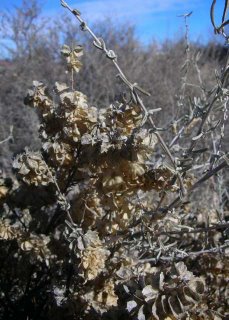 What’s blooming outside: Nothing.
What’s blooming outside: Nothing.What’s blooming inside: Aptenia, zonal geranium.
What’s green and visible in the area: Needle grass and other unidentified grasses: agave, yucca, yew, juniper, arborvitae, piñon and other pines. People down the road burned weeds along road and fences.
What’s green in my yard: Columbine, rose stems, thrift, rockrose, coral bells, hollyhock, vinca, coreopsis, Mount Atlas daisy, horseweed.
What’s gray: Snow-in-summer, buddleia, pinks, Greek yarrow, golden hairy aster, four-winged salt bush.
What’s red: Cholla, pinks, coral beardtongues.
Animal sightings: Dog and cat sized prints in mud.
Weather: Warm temperatures continue to melt snow into saturated soil sitting atop frozen ground that refreezes at night. Some snow survives in north and west areas in shadows of slopes, buildings or fences.
Weekly update: Who would think a plant we send to Iran and Uzbekistan to mediate ecological disasters would be fussy in New Mexico?
Atriplex Canescens doesn’t even have a common name. Frederick V. Colville called it Four-wing Saltbush for the Bureau of Plant Industry. Spanish speakers have several terms, including Chamiso. The Tewa living among the Hopi in Hano, Arizona called it ‘Tajaen
The mound-shaped shrub evolved in central México, then moved north through the Sonoran and Chihuahuan deserts. It survives with 8" to 12" of rain a year and is found anywhere from below sea level to 8,000'. Taproots that can reach down 20' tolerate soils containing salt, selenium, boron, and alkalis, but accept slightly acid soils, deep sandy loams, heavy clays, and gravel washes.
Saltbush has been used to reclaim abandoned mine sites and rescue eroded grazing lands. The leaves contain high levels of protein and carotene in the winter, but saponin makes them unpalatable in the summer when they’re producing seed. If the soil is saline, the leaves may exude salt into their surface flakes.
The Chenonpodia species has male and female plants, but the females morph into males when there’s not enough water. Genetically, some plants have double sets of chromosomes, some three, and some four. While the plant tends to keep its narrow grey leaves in winter, it will drop them when times are bad, and some have even adapted by growing from spreading roots rather than windblown seeds.
A male shrub appeared in 1992 uphill from my neighbor’s new septic field. A male and female were blooming downhill from mine in 2000, some six years after the tank was installed. The original plant is about 4' high, mine closer to 6'.
This year, I noticed two new plants expanding the copse that already had attracted winterfat and yellowbrush. Another was growing uphill, about 3' from a water line. So far they have produced no seed heads, but the young plants have more leaves than the older ones this winter.
This preference for lands that border disturbances led Charlie Steen, an archaeologist with the National Park Service, to use the presence of stands of Saltbush to locate possible ruins on the Pajarito plateau. It usually wasn’t directly over the ruin, but atop the middens, usually rubbish heaps, that accompany settlement.
Some plants are growing down the road where an abandoned roadbed cum arroyo goes under the road; they remain short, probably because county road crews cut them down in late summer. If they’re anywhere else in the area, the dense upright branches are indistinguishable from other brush. More likely, they’ve been eaten, or the seeds are just very picky about where they germinate.
Picture: Female Fourwinged Saltbush, with empty seed cases; male shrub in rear without cases. 4 February 2007.
No comments:
Post a Comment